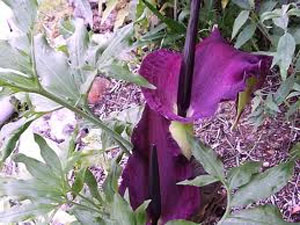Dragon Lilies Flowers
Dragon lilies, (which aren’t true lilies as they’re not in the genus Lilium) are scientifically known as Dracunculus vulgaris and are more appropriately classified as Arums, not lilies. Still, the dragon lily nickname has stuck along with several other aliases including “snake lily”, “stink lily” and “black lily”. These interesting plants originate across the Balkan region of Southeastern Europe and could be found as far south as Greece and the Aegean Islands. Despite some of its less desirable characteristics, the dragon lily has been introduced to the United States and currently lives wild in Oregon, California and Tennessee. The dragon lily has even made its way south of the continental US to Puerto Rico. While by visual inspection alone, the plant looks relatively unattractive, the smell of this commonly termed “lily” is what turns people off to keeping the plant indoors.

A Unique Lily Variation
The dragon lily has a unique purple spathe and spadex, which is the most prominent visual characteristic of the plant. A spathe is the almost cocoon-like encasement of petals protecting seed sacks at the center of a flower and the spadix is the long plant flesh protrusion that usually hosts small flowers. This plant is called the dragon lily because the spadex resembles a dragon’s tail. It was rumored in Greece that dragons lived within the plants leaving their tails hanging out as they slept. Female flowers are more erect with a thicker spadex stemming directly upward out of the stem, wrapped around by a thick spathe. Male plants are lower lying and feature the characteristic, bright, purple petals around a dragon tail-like spadex that sticks immediately upward out from the stem at the base of the petal.
Growing a Dragon Lily
To plant and grow a dragon lily you must first make a hole roughly twice the length and width of the tuber bulb that you’ll be planting and then drop the tuber inside. To fill the hole, use roughly four inches of African violet soil mix. Be sure before covering your tuber that the pointed top is facing upward! This will allow the stem to easily reach up through the surface of the potting mix once strong enough. If you can’t tell up from down when it comes to the tuber, the safest thing to do is plant it sideways. Water till moist – not saturated. Fertilize your plant every two weeks once it starts steadily growing.
Not Your Typical Floral Aroma…
The dragon lily is not also called the “stink lily” for no reason: this plant emits a noxious smell during its short, one to two day bloom that has been likened to death, decaying flesh and carcasses. There have actually been accounts of vultures circling over the plant and digging them up in search of meat. If you’re truly interested in planting and keeping a dragon lily, be sure to plant it somewhere that won’t offend nasal passages of neighbors and family members. This plant is by far not an indoor plant.
